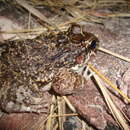Comprehensive Description
(
англиски
)
добавил Smithsonian Contributions to Zoology
Leptodactylus rugosus Noble, 1923
Leptodactylus rugosus Noble, 1923:297. [Type-locality: near Kaieteur Falls, British Guiana. Holotype: AMNH A–1169, adult male.]
DIAGNOSIS.—As the name implies, most individuals of rugosus are rugose. The degree of dorsal wartiness of most rugosus is only approached by some labyrinthicus, but the condition in labyrinthicus is glandular, not tubercular as in rugosus. Leptodactylus rugosus is a moderate-sized species (maximum adult SVL 86 mm) that usually lacks dorsolateral folds. Leptodactylus fallax, flavopictus, labyrinthicus, pentadactylus, and knudseni are large species (minimum adult SVL 97 mm) with distinct dorsolateral folds (a few labyrinthicus lack dorsolateral folds). Leptodactylus laticeps has a tile-like dorsal pattern (Figure 1, F) and is larger (minimum adult SVL 91 mm) than rugosus, which does not have a tile-like pattern. Leptodactylus rhodomystax has a distinct light stripe on the upper lip; rugosus does not have a distinct light lip stripe. The dorsolateral folds are interrupted in the few rugosus that have folds; all rhodonotus and stenodema have continuous folds. Most rugosus have smooth soles of the foot; most syphax have tuberculate soles of the foot.
ADULT CHARACTERISTICS (N=42).—Dorsum uniform, spotted, or blotched (Figure 1, C, D, H–K); lip uniform or usually with a complex dark and light pattern (Figure 2, A, C, E, F, J, K, M, N); posterior surface of thigh variously mottled (Figure 3, A, C, D, J, P, R); upper tibia distinctly or indistinctly barred (Figure 4, A, C, E); usually no dorsolateral folds, rarely an interrupted pair of folds from eye to midbody; fold from eye above tympanum to shoulder not dark outlined; no fold from above tympanum to shoulder; male thumb usually with one spine per hand, sometimes two; male chest spines present or absent; upper tibial and distal tarsal texture smooth or with scattered to many white- or black-tipped tubercles; sole of foot smooth or scattered with white- or black-tipped tubercles; female SVL 68.2±8.9 mm, maximum 85.7 mm, male 59.8±5.3 mm, maximum 68.3 mm; female interorbital distance/head length ratio 0.16±0.02, male 0.16±0.02; female eye-nostril distance/head length ratio 0.24±0.01, male 0.24±0.01; female head length/SVL ratio 0.38±0.01, male 0.38±0.01; female head width/SVL ratio 0.39±0.01, male 0.39±0.01; female femur/SVL ratio 0.45±0.03, male 0.44±0.02; female tibia/SVL ratio 0.45±0.03, male 0.45±0.02; female foot/SVL ratio 0.47±0.03, male 0.47±0.03.
DISTINCTIVE COLORS IN LIFE.—Throat and belly of females white and ventral surfaces of hind limbs cream with gray suffusion. (W. E. Duellman, pers. comm.)
LARVAL CHARACTERISTICS.—Eye diameter 12–14 percent head-body length; oral disk subterminal; oral disk laterally indented; oral disk width 20–28 percent head-body length; anterior oral papilla gap 80–88 percent oral disk width; split tooth row anterior to beak just less than 1/2 length of entire tooth row anterior to beak; 37–65 denticles in split tooth row anterior to beak; tooth row formula head-body length 26–32 percent total length; maximum total length, stage 41, 41.3 mm.
MATING CALL.—Dominant frequency modulates from between 600–2300 Hz to 700–2700 Hz (Figure 17); no harmonic structure in call; call complexly pulsed and partially pulsed (Figure 18); a short, approximately 0.03 s pulse of lower frequency (600–700 Hz) (Figure 18) immediately followed by a 0.49 to 0.64 s pulse train of higher frequency (1300–2300 Hz to 1500–2700 Hz) (Figure 17 shows this part of call only, Figure 18 shows both lower and higher frequency components).
KARYOTYPE.—Unknown.
DISTRIBUTION (Figure 16).—This species is restricted to granitic rock outcroppings in the Guiana shield region from Colombia to French Guiana.
COLOMBIA. VAUPÉS: Cerro Patava (UTA 3724–25, 3772–85, 3857, 3859–61, 3863–77).
FRENCH GUIANA. Montagne St Marcel (LES 426b); Peolaeu (Haut-Oyapock) (LES 4197).
GUYANA. Kartabo (AMNH 70904–08, USNM 118063–64, 129537–38); Kurupung, upper Mazaruni Dist (UMMZ 85211); Membaro Creek, upper Mazaruni R (UMMZ 85155–57, 85210, USNM 118684); Tukeit Hill, below Kaiteur Falls, Tumong Dist (AMNH 1166–68, 3789).
SURINAM. Raleighvallen–Voltzberg Nature Reserve, Voltzberg Camp, W bank Coppename R (MCZ 92363).
VENEZUELA. AMAZONAS: Misión Coromoto-Atures (USNM 137186–92); Puerto Ayacucho (AMNH 23209–19, FMNH 175460–65, 176197–222, USNM 80634, 80665–73, 133186); Puerto Sanariapo (USNM 80635–39). APURE: Hato Caribén, 46 km NE Puerto Páez, Río Cinaruco (USNM field 5625–26, 5820). BOLIVAR: 3 km E Canaiama (KU 117125); 85 km SSE El Dorado, km 125 (USNM field 8107, USNM 162698–99); km 104–151 on El Dorado-Santa Elena de Uairén Rd (KU 166498–524, 166531–544); Laja, at mouth of Río Parguaza, 100 m (AMNH 62168); Mt Auyantepui, 1100 m (AMNH 46038–39); Paso de El Danto (KU 166525–30); W Wiaka-Piapo Mt, 20 mi from Guyana border, 5000’ (UMMZ 85158, 85209). GUAINÍA: Río Negro opposite Casiquiare and Guainía (AMNH 23160–62).
- библиографски навод
- Heyer, W. Ronald. 1979. "Systematics of the pentadactylus species group of the frog genus Leptodactylus (Amphibia, Leptodactylidae." Smithsonian Contributions to Zoology. 1-43. https://doi.org/10.5479/si.00810282.301

